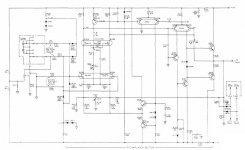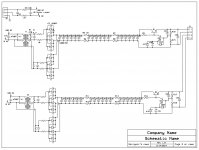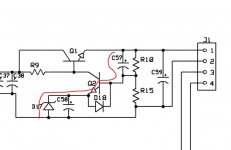Scott,
That paper is from 1968! Haven't you been following the complaints that 40 year old stuff doesn't count. 🙂
ES
Nice cite.
That paper is from 1968! Haven't you been following the complaints that 40 year old stuff doesn't count. 🙂
ES
Nice cite.
Scott, I think you had Graeme J. Cohen Preprint 2106 "Double Balanced Microphone Amplifier" in mindfollowing the Forsell AES paper since basicly Demrow's circuit
And he posted values too, Wait until SE gets out of daycare ..... 🙄
I'm getting a little tired of you right about now.
se
Scott, I think you had Graeme J. Cohen Preprint 2106 "Double Balanced Microphone Amplifier" in mind
Yes, yes I forgot Forsell credits Cohen and I think sells a commercial version. As far as I'm concerned the circuit is public domain.
Last edited:
I'm getting a little tired of you right about now.
se
Dats funny , if you going to throw jabs around loosely you should Keep your right up ......

The classic current feedbackAlexander amp. Those simulation values are absurd, probably due to very rough output mosfet models.
Thanks. I agree the sim is way to optimistic... just wondered by how much.
Attached is my preamp power supply.
A few notes;
The input fuse should be at least 5 amps time delay. (Not Shown.)
The transformers should be sized so that when the secondary is shorted they will blow the fuse.
The transformers should be placed in a steel enclosure and the safety ground attached to it.
The enclosure should be floated on rubber grommets from the chassis.
No wirewound resistors should be used.
ES
A few notes;
The input fuse should be at least 5 amps time delay. (Not Shown.)
The transformers should be sized so that when the secondary is shorted they will blow the fuse.
The transformers should be placed in a steel enclosure and the safety ground attached to it.
The enclosure should be floated on rubber grommets from the chassis.
No wirewound resistors should be used.
ES
Attachments
Last edited:
Ed,
Those 220puf's transport all hf hash directly from the secondary to the rest of the supply. Lose them and use soft recovery diodes!
Jan
Those 220puf's transport all hf hash directly from the secondary to the rest of the supply. Lose them and use soft recovery diodes!
Jan
Dats funny , if you going to throw jabs around loosely you should Keep your right up ......
The good-natured jab was at Pavel, not you.
se
Ed,
Those 220puf's transport all hf hash directly from the secondary to the rest of the supply. Lose them and use soft recovery diodes!
Jan
No, the value is chosen so that they reduce the switching noise to a few dB above the incoming line noise. I thought I gave you that preliminary article with the data.
Also pay attention to the secondary phasing. Most noise gets cancelled.
Any concerns over low impedance paths like this and possible reliability/degradation issues with the error amp over time ?
Possibly, but the circuit has been used since the 60's.
The output rail can be shorted to zero, which is handled by the reverse diode. To get a spike large enough to degrade the base junction would not be expected from the rest of the load.
But if you screw up the ratio between C57 & C59 you might become vulnerable under some conditions.
Last edited:
Also pay attention to the secondary phasing. Most noise gets cancelled.
Ed, how perfect is the symmetry of stray capacitances?
- Status
- Not open for further replies.
- Home
- Member Areas
- The Lounge
- John Curl's Blowtorch preamplifier part II


